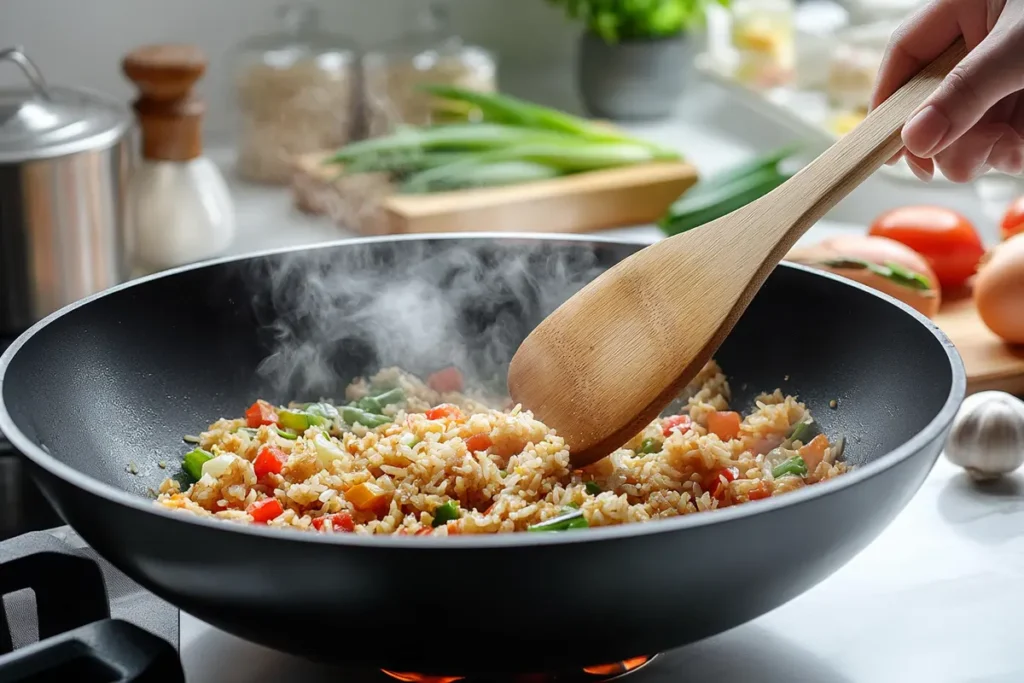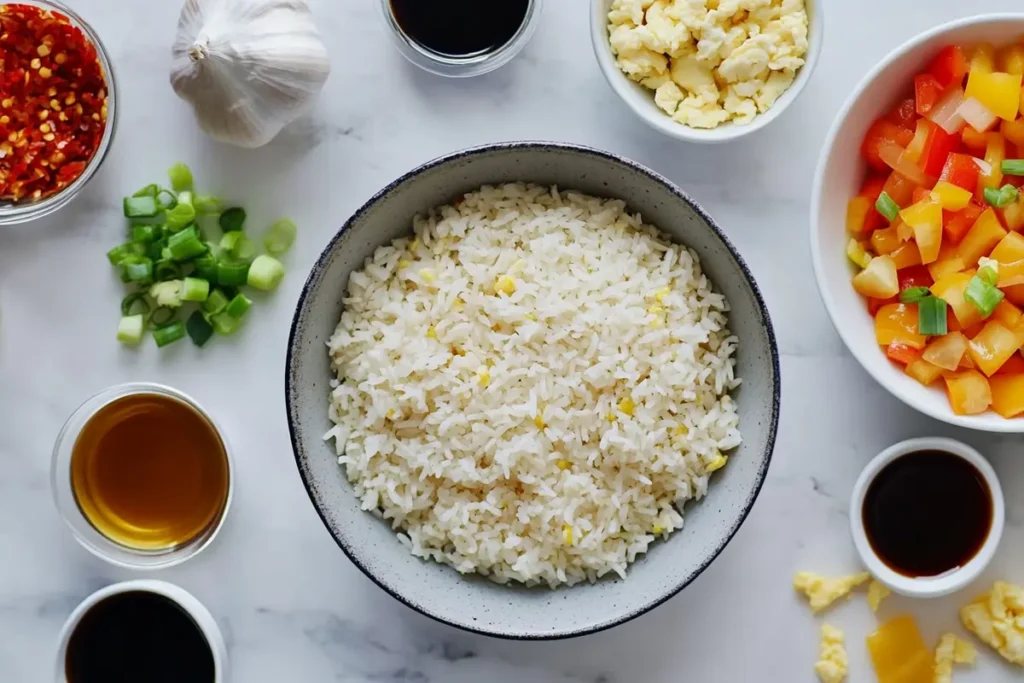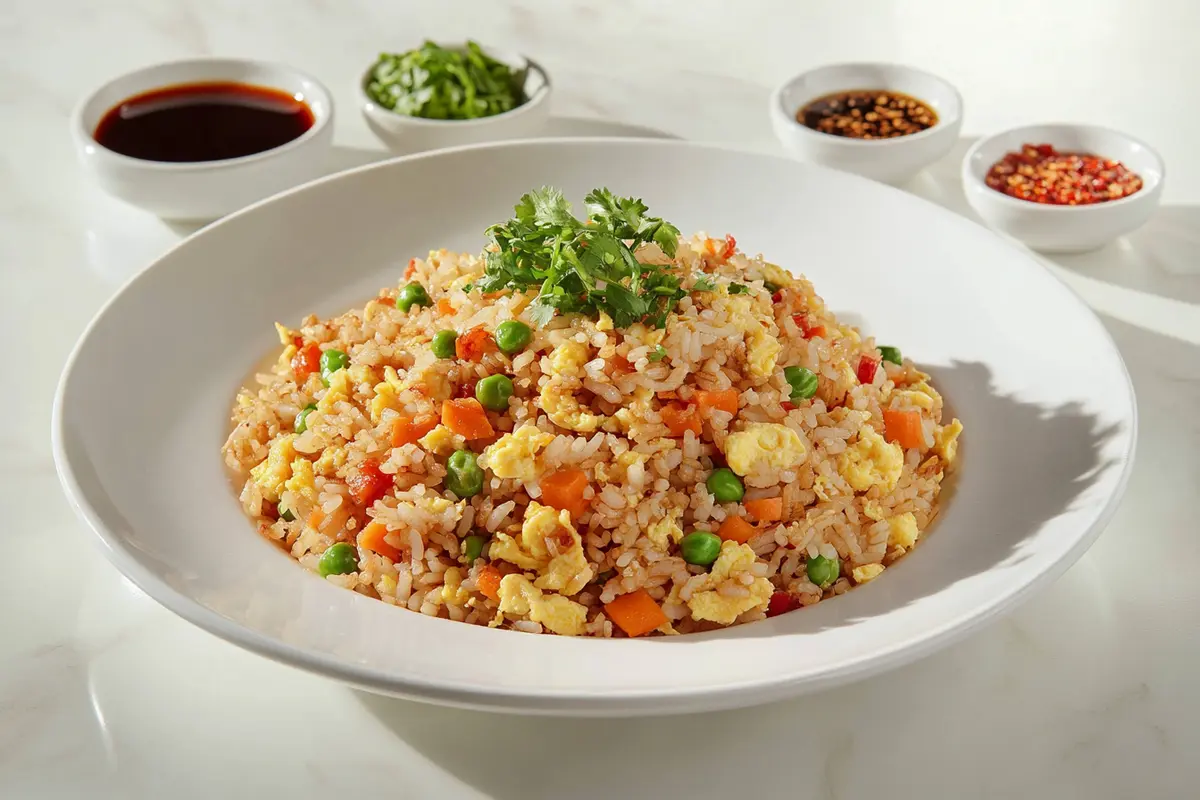Chinese fried rice is a globally beloved dish, celebrated for its irresistible aroma, vibrant colors, and layers of flavor. But have you ever wondered what gives Chinese fried rice its flavor? Is it the umami-rich soy sauce, the smoky wok hei effect, or the perfect balance of ingredients? This article dives deep into the secrets behind this iconic dish, unraveling the role of essential ingredients, traditional cooking techniques, and a few surprising additions that make it so flavorful. Whether you’re a home cook or a culinary enthusiast, you’re about to uncover everything you need to recreate authentic Chinese fried rice. Let’s start by exploring its history and significance.
Overview about Chinese Fried Rice
The Popularity of Chinese Fried Rice
Chinese fried rice has become a culinary staple across the globe, thanks to its simplicity, adaptability, and bold flavors. From bustling Chinese street markets to cozy family dinners, this dish embodies the essence of comfort food. Its popularity stems from its versatility; it can be a humble dish made with leftover rice or a luxurious entrée studded with shrimp, pork, or premium cuts of meat.
Cultural Significance and Regional Variations
Fried rice isn’t just a meal; it’s a reflection of Chinese history and regional diversity. Originating from Southern China, where rice is a dietary staple, it was initially created as a way to repurpose leftovers. Over time, regional variations developed, each showcasing unique ingredients and techniques. For instance, Cantonese fried rice leans toward light, mild flavors, while Sichuan fried rice packs a punch with spicy chili oil and peppercorns.
Why Understanding Flavor Is Essential
Creating great Chinese fried rice is about more than just throwing ingredients together—it’s an art. Each component, from the choice of rice to the cooking process, contributes to the final flavor. By understanding these elements, you can recreate the complex yet harmonious taste of authentic fried rice in your kitchen. As we delve into this dish’s flavorful secrets, you’ll learn not just what gives Chinese fried rice its flavor but also how to elevate your own cooking skills.
The Role of Ingredients in Flavor
Essential Base Ingredients of Chinese Fried Rice
One of the most critical components in understanding what gives Chinese fried rice its flavor lies in its foundation: the base ingredients. At the heart of any great fried rice is the rice itself. Day-old rice is often preferred because it has a firmer texture, which prevents clumping and ensures each grain is evenly coated in flavor. Freshly cooked rice, on the other hand, can be too soft and sticky, making it harder to stir-fry effectively.
Next comes the all-important soy sauce. This savory, salty ingredient not only adds color but also imparts an umami-rich depth that enhances every bite. Traditional recipes often balance regular soy sauce with light soy sauce for complexity. A splash of dark soy sauce can create a deeper hue, while low-sodium options allow for healthier adaptations without compromising taste.
Vegetables and Proteins
No fried rice is complete without its colorful mix of vegetables and protein options. Fresh vegetables like carrots, peas, and bell peppers not only add vibrant hues but also offer sweetness and crunch that balance the umami-rich sauces. Proteins like shrimp, diced chicken, pork, or tofu elevate the dish, creating a hearty meal that satisfies any craving.
Interestingly, proteins are not just about taste—they play a key role in flavor development. When cooked on high heat, meats release juices that mingle with the rice, creating an even more robust taste. Vegetarian versions can substitute mushrooms or plant-based proteins to mimic the umami effect.
Seasonings and Aromatics: Fried Rice Taste Secrets
Beyond the main ingredients, aromatics like garlic, ginger, and green onions are indispensable. They’re often sautéed first to infuse the oil with their bold flavors, setting the stage for the rice to soak up these fragrant notes. A dash of white pepper, a sprinkle of salt, and perhaps a touch of chili oil for spice round out the flavor profile.
Cooking Techniques That Define the Flavor
The Wok Hei Effect

One of the most distinctive answers to what gives Chinese fried rice its flavor is the wok hei—a Cantonese term that translates to “breath of the wok.” This smoky, slightly charred aroma is achieved by cooking over extremely high heat in a seasoned wok. The intense heat caramelizes the ingredients, creating a deep, savory profile that’s hard to replicate with standard stovetop pans.
To achieve wok hei, chefs ensure the wok is searing hot before adding oil and ingredients. The heat not only sears the rice but also helps evaporate moisture, keeping the dish dry yet flavorful. This smoky quality is what often separates homemade fried rice from restaurant versions.
Stir-Frying Techniques for Chinese fried rice
Equally important are the stir-frying techniques that allow flavors to build and blend harmoniously. Chefs typically start by cooking aromatics like garlic and ginger, followed by proteins and vegetables, and finally the rice. This step-by-step process ensures that each ingredient gets the right amount of heat and seasoning.
Proper stirring is essential, as it prevents sticking and evenly distributes the sauces. Using a spatula or wooden spoon to toss the rice ensures every grain is coated in the rich umami flavors of soy sauce, oyster sauce, or sesame oil. Additionally, quick, continuous motion keeps ingredients from overcooking, preserving their textures and flavors.
Balancing Heat and Texture
Another crucial technique involves managing heat levels. High heat is critical for achieving the signature wok hei, but knowing when to lower the temperature prevents burning delicate ingredients like eggs or leafy greens. Mastering this balance results in a dish that’s crisp, aromatic, and bursting with flavor.
Secret Ingredients for the Perfect Taste

Oyster Sauce and Hoisin Sauce: Adding Depth
If you’ve ever wondered what gives Chinese fried rice its flavor, one key answer lies in oyster sauce and hoisin sauce. These sauces provide a rich, umami-packed taste that complements the simplicity of the rice and vegetables. Oyster sauce, with its slightly sweet and briny notes, brings a depth of flavor that ties the dish together. On the other hand, hoisin sauce adds a hint of sweetness and complexity, making the dish taste more balanced and satisfying.
Sesame Oil and Peanut Oil: The Aromatic Boost
The choice of cooking oil plays a significant role in flavor development. Sesame oil, often drizzled toward the end of cooking, provides a nutty aroma that elevates the dish. Its fragrance is unmistakable, signaling the authentic taste of Chinese cuisine. Similarly, peanut oil, used for stir-frying, adds a subtle richness without overpowering the other ingredients. The combination of these oils ensures a harmonious blend of taste and texture.
The Role of Eggs: A Flavorful Binder
Eggs are more than just a source of protein in fried rice—they act as a flavor binder. When scrambled directly in the wok, eggs absorb the rich seasonings and help distribute them evenly throughout the dish. Their creamy texture balances the smokiness from the wok hei, creating a dish that’s both hearty and flavorful.
For more fried rice inspiration, check out this related recipe: Fried Rice with Egg, Chicken, and Shrimp.
Variations and Modern Twists
Fusion Fried Rice Recipes: Mixing Cultures
Modern takes on fried rice incorporate flavors from across the globe. Whether it’s Thai-inspired fried rice with a splash of fish sauce or Japanese-style fried rice featuring miso paste, these twists highlight the dish’s adaptability. Fusion recipes often use quinoa, cauliflower rice, or brown rice as a base, catering to health-conscious diners while maintaining bold flavors.
Spices and Unexpected Additions
To add a unique kick, many chefs include unexpected ingredients like chili paste, fish sauce, or even curry powder. These additions not only enhance the taste but also bring vibrant colors to the dish. For those seeking a vegetarian option, tofu marinated in soy and sesame sauce makes an excellent substitute for traditional proteins.
Experimenting with ingredients allows you to create a fried rice recipe that reflects your personal tastes while retaining the essence of what gives Chinese fried rice its flavor.
Frequently Asked Questions
Why Is Day-Old Rice Preferred?
Many home cooks ask why day-old rice is ideal for fried rice. The answer lies in its texture. Freshly cooked rice tends to be moist and sticky, making it harder to stir-fry evenly. In contrast, day-old rice is drier, allowing the grains to separate and soak up the sauces better. This ensures each bite is bursting with flavor, highlighting what gives Chinese fried rice its flavor.
Can You Make Chinese Fried Rice Without Soy Sauce?
Yes, you can! While soy sauce is a traditional ingredient, it’s not the only source of flavor. Alternatives like tamari, coconut aminos, or even a pinch of salt and pepper can be used. To achieve the signature umami, you might add oyster sauce, fish sauce, or a splash of sesame oil. Each option contributes its unique twist while keeping the dish authentic.
What Gives Fried Rice Its Smoky Flavor?
The smoky aroma, known as wok hei, is achieved by cooking over high heat in a seasoned wok. This high heat caramelizes the rice and other ingredients, infusing the dish with a slightly charred flavor that’s hard to replicate at home without the right equipment.
What Are Good Vegetarian Substitutes?
Vegetarians can enjoy fried rice by using tofu, mushrooms, or even jackfruit as protein substitutes. These ingredients absorb sauces beautifully, ensuring the final dish is just as rich and flavorful.
Final Tips
Chinese fried rice is more than just a side dish—it’s an art form that combines the right ingredients, precise techniques, and a bit of culinary flair. From understanding what gives Chinese fried rice its flavor to mastering the smoky wok hei, every element plays a crucial role in creating this beloved dish.
To make your fried rice unforgettable, always start with day-old rice and cook it in a hot wok. Balance your base ingredients, add a splash of soy or oyster sauce for depth, and finish with aromatic oils like sesame or peanut. Don’t be afraid to experiment with fusion flavors or modern twists to suit your taste.
With these tips and insights, you’re well on your way to crafting a fried rice masterpiece that rivals your favorite takeout. Ready to give it a try? Happy cooking!

